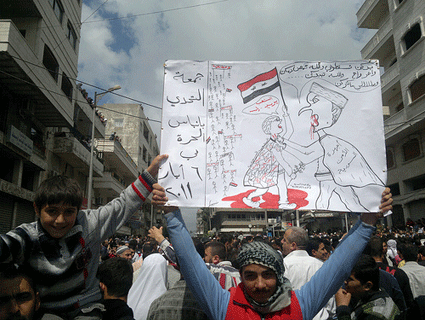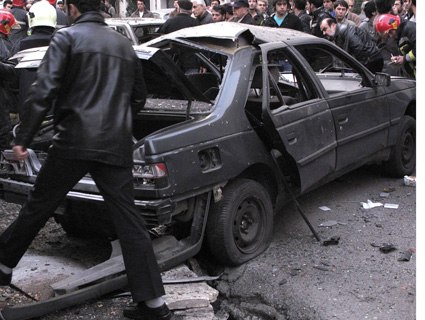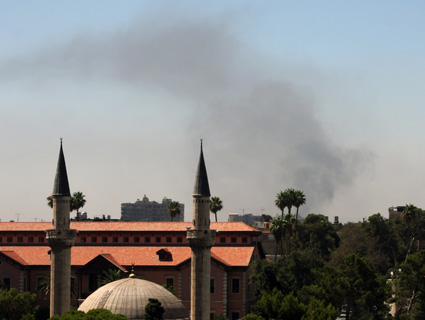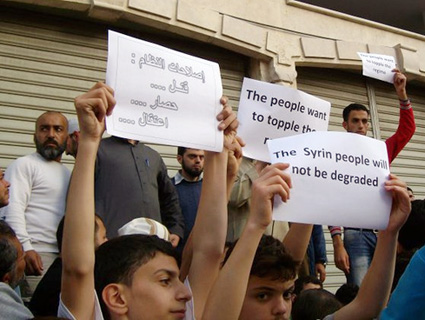
Syrian protesters in May 2011<a href="http://www.flickr.com/photos/syrian-freedom-captured/5736179151/in/photostream">Syria-Frames-Of-Freedom</a>/Flickr
Update, 7/3/12: Human Rights Watch has released a major report detailing 27 torture centers operating around Syria, including specific locations, commanders’ names, and torture methods used.
Update, 5/27/12: At least 32 children were reportedly among the more than 90 people slaughtered by Syrian military forces in the village of Houla on Saturday.
A 718-page digital document obtained by Mother Jones contains names, phone numbers, neighborhoods, and alleged activities of thousands of dissidents apparently targeted by the Syrian government. Three experts asked separately by Mother Jones to examine the document—essentially a massive spreadsheet, whose contents are in Arabic—say they believe that it is authentic. As Bashar al-Assad’s military continues a deadly crackdown on dissent inside the country, the list appears to confirm in explicit detail the scale of the regime’s domestic surveillance and its methodical efforts to destroy widespread opposition.
The document does not contain any identifying government markings. But the experts consulted agree that its organization and content—which they say is striking in scope—are characteristic of lists used by intelligence services in the Middle East. A link to the document, which surfaced in mid-January in discussions about Syria on Twitter, was provided to Mother Jones by a self-described hactivist who tweets frequently in Arabic and English and whose identity is unclear. A redacted sample of the document is below; Mother Jones is not publishing the full document or revealing the names of individuals in it because we cannot definitively confirm its authenticity nor predict how the document might be used if more widely disseminated.
But the experts who examined the document say it shows what many observers have strongly suspected: In addition to relentless bombing of cities such as Homs and Hama, the Assad regime is tracking down thousands of its own people for interrogation, coercion, or far worse. Joshua Landis, a scholar on Syria who has consulted for the State Department and other US government agencies, said he thinks the document merges the records of several Syrian intelligence agencies in order to better coordinate the crackdown. “This is what a secret service does,” he said. Actions allegedly taken by individuals in the document—such as setting up a roadblock near Homs or issuing instructions about how to attack a Syrian military outpost—are “the kind of thing that people get whacked for all the time, or at least tortured for.”
According to Ammar Abdulhamid, a Syria expert and fellow at the conservative Foundation for Defense of Democracies, the document contains the names of people wanted by the government’s military and security services. It lists many of them with specific information—the year of their birth, names of their relatives, and descriptions such as, “he leads rallies in the Sakhaneh neighborhood.” The list also includes military defectors and their units and ranks, Abdulhamid said. “This kind of info on this scale cannot be available to the general public, or faked.”
The hactivist who alerted Mother Jones to the online document said that it was posted by members of an activist organizing committee inside Syria, but declined to provide any details confirming that, citing security concerns. It’s conceivable that the document involves deception by the Syrian regime or counterintelligence operations by its adversaries; the United States, Israel, and other Western powers are known to have run sophisticated covert operations against Syria and Iran for many years.
Andrew Tabler, a Syria expert and fellow at the Washington Institute for Near East Policy, agrees that the list appears to be authentic, despite that there is no way to know for sure. “The way it’s organized looks similar to other documents I’ve seen,” he said, citing a hit list he saw when he was in Syria in 2006. (That list, he said, also did not contain identifying government markings.) “It organizes people in such a way that it would allow the security services to be able to track them down.” Tabler also said the document is longer than any he’s previously seen; it allows the Syrian government to “more effectively round up these folks and choke them off as part of the crackdown.”
Here is a sample from the top of page 1 of the document, which was translated from the Arabic by Abdulhamid.

(The English above corresponds to the headers and content of line 1 below; the columns are flipped, as Arabic is read from right to left.)

A Syrian student living in Europe who actively supports the opposition movement also examined the document and said that it is “very encompassing” and includes details on “activists who make things happen on the field and military defectors.” A note above a section near the end of the document, he said, suggests that the names of the people it contains were extracted through confessions.
The infamy of Syria’s Mukhabarat intelligence service is well known. For the past year, reports of it rounding up and torturing Syrian activists have steadily trickled out of the country. “When they took me in, they put me face down on the floor, and started beating me with a cable on the soles of my feet, my legs and back,” a Syrian protester told Human Rights Watch last year. “They were asking, ‘Why did you go to the demonstration? Who paid you to go? Who made you go?’ They just wanted me to confess to something, did not matter what.”
“I have seen lists that had hundreds of names listed in the same manner,” Abdulhamid said. “Some were published on the web by activists to warn people. Others included names of people who were later arrested or killed. Activists have reported since the early days of the revolution that when loyalist security forces came to their neighborhoods, they indeed carried a list of names in their hands and were looking for specific people, in addition to making random arrests or arresting relatives of the people whose names they had.”
He added: “It is possible that some of these lists have been leaked intentionally and that they contain names of pro-Assad elements to be used as bait for catching activists. The dynamics of the revolution have become very complex—there is active cyberwar going on, intelligence and counterintelligence, propaganda and counterpropaganda, and the regime tends to have the upper hand in these fields.”
Landis, who also runs the influential blog Syria Comment, says he thinks the scale of the document highlights “how overwhelmed the security forces clearly are with this uprising. They’re trying to keep track of leadership and who’s in the opposition, and it’s reaching into the thousands upon thousands.” Even for a regime as systematically brutal as Assad’s, it’s an immense undertaking. “They have to go out and find these people’s homes and interrogate their families, and then try to track these people down.”
Landis believes that the Arab Spring and the rise of social networks have weakened the iron grip that the regime has had on the country for more than four decades. “It’s way out of control…it’s on Facebook, it’s using all these technologies they don’t understand and were not up to speed on,” he said. “All of a sudden these large networks of people who were connected through this new technology, it overwhelmed them. It wasn’t people just making phone calls on the old hard lines the government had completely wired.”
Still, ever since the uprising began last March, the regime has shown that it will go to extreme lengths to crush the opposition. The situation turned particularly grim this month: There have been reports of hundreds massacred, including women and children, the US shut down its embassy in Damascus, and Western journalists have been killed. (For more details and essential background, read our updated Syria explainer.)
Western countries, in cooperation with several Arab countries like Saudi Arabia and Morocco, pursued a UN resolution calling for an end to Assad’s rule. It failed in early February, with Russia and China vetoing. On Friday, Secretary of State Hillary Clinton and other international leaders gathered in Tunis, calling for humanitarian aid and a UN peacekeeping force to be allowed into Syria. President Obama also weighed in, saying, “We are going to continue to keep the pressure up and look for every tool available to prevent the slaughter of innocents in Syria.” But as the violence goes on, options for a coalition of outside governments to intervene appear to remain limited.
















